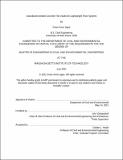Autoclaved Aerated Concrete Tile Vaults for Lightweight Floor Systems
Author(s)
Jagoe, Grace Anne
DownloadThesis PDF (2.443Mb)
Advisor
Ochsendorf, John
Terms of use
Metadata
Show full item recordAbstract
In the construction of multistory buildings, the reinforced concrete flat slab is a preferred floor system in part due to ease of formwork construction, which does not require skilled labor. However, the flat slab carries load primarily in bending, forcing much of the concrete section to crack because of the low tensile capacity of concrete. Thus, up to 61% of the material in the floor system may contribute to the structural weight without carrying substantial load. Material inefficiencies such as this are expensive not only from a cost perspective, but also from an environmental perspective. The embodied carbon of a structure, the emissions of CO2e associated with material consumption, is directly proportional to the weight of material. With the demand for new construction on the rise, the urgency for more sustainable buildings necessitates more efficient use of material to reduce the embodied carbon associated with structural floor systems.
This thesis explores the use of tile vaults as permanent formwork for concrete floor systems. The proposed system is lighter weight than traditional flat reinforced concrete slabs due to the structural efficiency of material: concrete carries load to the supports in compression and steel resists the outward thrust in tension. Drawing upon traditional masonry construction techniques, a square groin vault can be built using lightweight autoclaved aerated concrete (AAC) tiles and fast-setting mortar without the need for complex falsework. The vaulted floor is designed using equilibrium calculations for various load cases to ensure stability throughout the lifespan of the structure. Alternative geometries and concrete mixes are studied to optimize the system, resulting in a vaulted floor with 67% reduction in structural weight and 61% reduction in embodied carbon compared to a conventional concrete flat slab. Finally, experimental testing validates three possible mortars for the use with AAC tiles for the construction of efficient vaulted floor systems.
Date issued
2021-06Department
Massachusetts Institute of Technology. Department of Civil and Environmental EngineeringPublisher
Massachusetts Institute of Technology